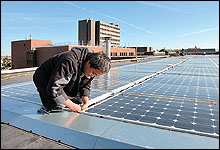Archives
University reaps "green" benefits
UB’s investment in energy conservation helping planet and the bottom line
By ELLEN GOLDBAUM
Contributing Editor
More than a decade ago, when the term "climate change" had not yet made its way into the national lexicon, UB made a major investment in reducing greenhouse gas emissions through a $17 million comprehensive energy-conservation project.

These solar panels, installed
recently on the roof of Norton Hall, will generate approximately 6
percent of the building’s annual electrical power consumption.
PHOTO: NANCY J. PARISI
The project has benefited not only the planet, but also the university's bottom line, saving the university nearly $15 million. On Jan. 31, UB made its final payment on the loan that partially funded the project. Beginning this month, with the project's debt retired, annual savings from it will jump to nearly $4 million, according to Michael F. Dupre, associate vice president for university facilities.
Savings generated by the project, he explained, have been even greater than originally projected because of the rising cost of energy over the years since its launch in 1997.
"It has freed up money for other institutional priorities, like hiring faculty," he added.
Dupre noted the serendipity in that the project's savings have surpassed its cost during the semester when the university is celebrating its environmental commitment under the theme "A Greener Shade of Blue."
"It is entirely fitting that we are reaching such an important environmental milestone this semester, when we are also fortunate to have some of the world's top environmentalists speaking on campus," Dupre said. For details about "A Greener Shade of Blue," go to http://www.buffalo.edu /greener_ub/ .
The project, which at the time was one of the largest ever undertaken on a U.S. college or university campus, was named "Energy Project of the Year" in 1997 by the Association of Energy Engineers.
It has reduced UB's total energy-related air pollution by 15 percent and cut its carbon dioxide emissions by 31,000 tons annually.
That's a level of emissions equivalent to the amount that 6,000 cars generate every year, according to data generated by the U.S. Environmental Protection Agency at http://www.usctcgateway. net/tool .
UB Energy Officer Walter Simpson, who managed the project for the university, noted that it "required no up-front money to be paid either by the university or New York State taxpayers."
About $13 million of the $17 million project was funded through the loan that was just paid back. UB also received a $4.3 million incentive from its utility, Niagara Mohawk Power Corp., now National Grid.
"It's hard to invest money at a better rate than this," Simpson said. "We're getting an annual return of 25 percent."
Eligibility for the incentive money required UB to guarantee that all energy-conservation measures would stay in place, producing energy savings for at least 15 years.
The project, which covered the North Campus, was a unique partnership between UB, Niagara Mohawk, Honeywell (formerly CES/Way International) and the SUNY construction fund.
"In implementing such a sweeping energy conservation program in the 1990s, UB and its facilities department put themselves well ahead of the curve for colleges and universities," said Bob Kennedy, east region vice president of Honeywell Building Solutions SES. "Because of the outstanding financial and environmental benefits the program delivered, UB is now able to dedicate more resources to academic excellence, its core mission."
Included among the broad array of conservation measures in the project were those that allowed for the reuse and recovery of waste heat; variable-speed controls for fan and pump motors; conversion of some electric space- and water-heating systems to natural gas; more efficient ventilation systems and brighter, more efficient lighting systems, both inside and outside UB buildings.
Encouraged by the success of the project, UB in 2005 embarked on its second major energy-conservation plan, focusing on the South Campus. The $11 million project, implemented by Chevron Energy Solutions, also will be paid for by savings at the meter.
A third such project, focusing on the North Campus, is now in the preliminary planning stages by University Facilities.
The 1997 project was by no means UB's first energy-conservation venture. By the early 1990s, UB already was a well-established leader in projects designed to curb energy use, having implemented more than 300 small and large energy-conservation projects beginning in the 1970s. All projects to date have resulted in more than $100 million in energy-cost savings.
University officials, however, realized that if more comprehensive energy savings were to be achieved, UB would have to undertake a comprehensive energy project involving an energy-service company and demand-side management incentive dollars, which were being made available by Niagara Mohawk.
In light of recent high energy prices, as well as more powerful evidence of global warming, that understanding has turned out to be both environmentally and financially fruitful.
A key ingredient to the success of the project was an agreement with the state that allowed UB to keep the dollars it saved on campus. Until then, UB's energy budget had been based on the university's average for the previous three years, so UB would have lost any savings it had generated through conservation measures.
